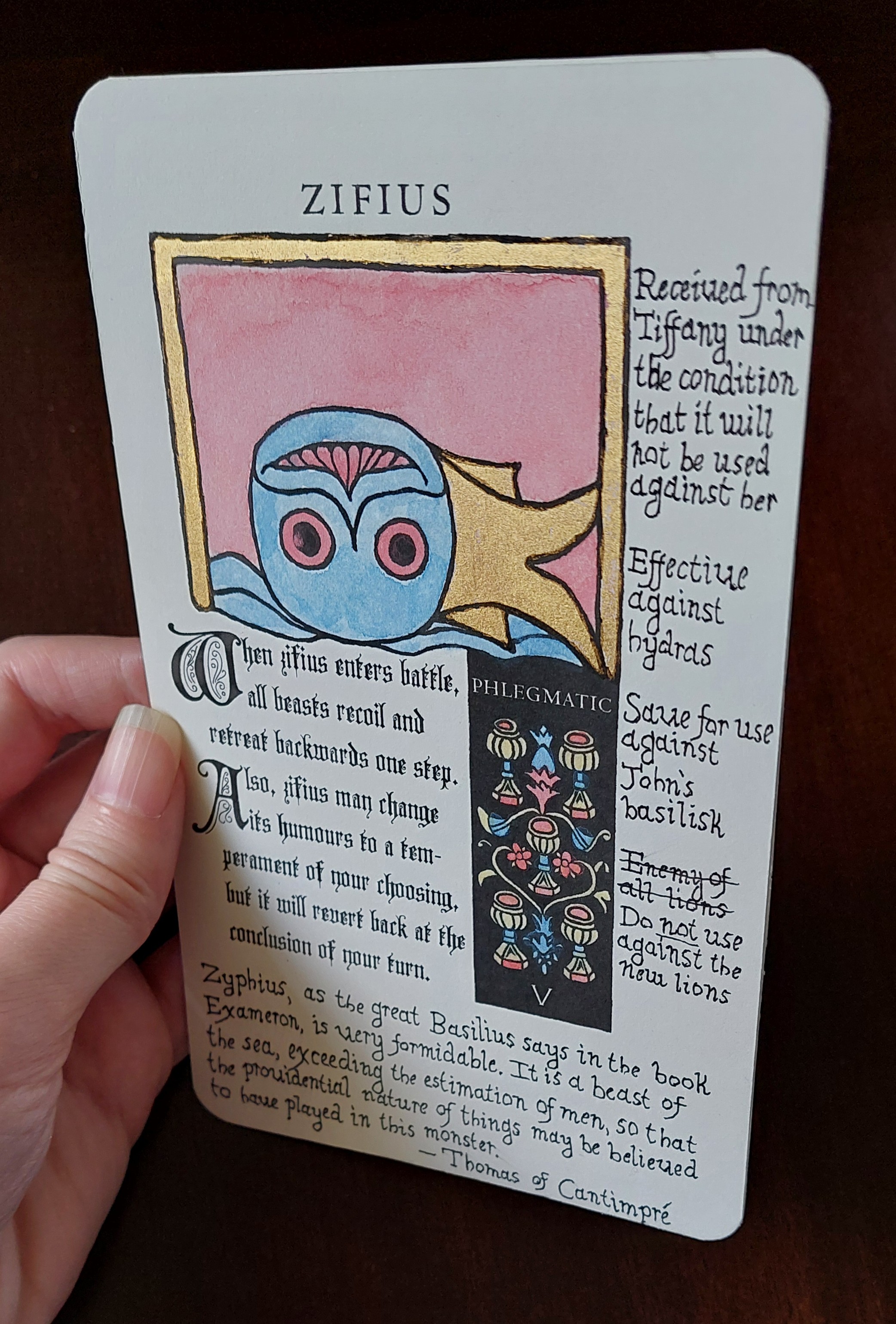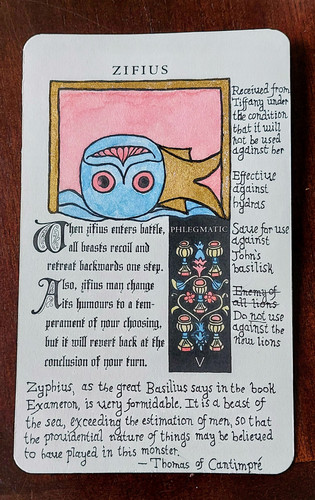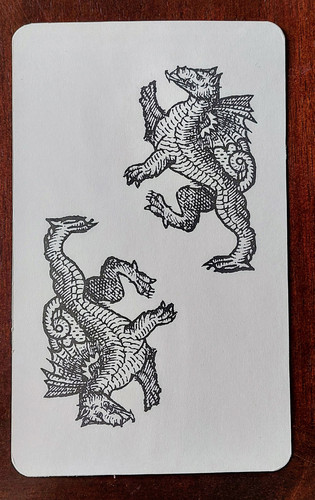Battle of the Beaſts—Zifius
A downloadable game
Battle of the Beaſts, commonly referred to as simply “Beaſts”, was a popular card game that originated at some point in the 15th century after the advent of the printing press in Europe.
The game reflects the transition period when handwritten manuscripts started to lose ground to printed books, and the paper industry grew and eventually overtook the parchment industry. Paper and printed products became far more accessible even among the lower class, hence the proliferation of playing cards like tarot.
The gameplay of Beaſts shares some similarities with the card game War (also known as Battle), and mostly consists of battles between attacking beaſts (recto cards) and an opponent’s defending beaſts (verso cards). The beaſts are paired off against each other, and the higher card value wins. Card values range from ace to 10. There are no court cards or trump cards.
However, there are four different temperaments (sanguine, choleric, melancholic, and phlegmatic), each corresponding to a different traditional card suit (swords, batons, coins, and cups), and each has a temperament that it is strong against and one that it is weak against. The order goes: phlegmatic > choleric > sanguine > melancholic > phlegmatic.
Card value counts for double against a temperament that your beaſt’s temperament is strong against. Aces count as 1’s normally, but count for maximum value when that beaſt is facing a temperament that it’s strong against. Ties go to the stronger temperament, if applicable. If there is a tie and neither temperament has an advantage over the other, the winner is decided by coin flip.
Defenders remain on the battlefield after successfully warding off an attacker, but any attacker who gets past the opponent’s defense is removed from play and placed face up in a pile. Defeated beaſts are placed facedown in a pile next to it. Whoever has the most victorious beaſts when both players are totally out of cards is declared the overall winner.
Attackers generally enter the battlefield in waves. There are three waves total, and you advance each of them one step closer to your opponent at the end of your turn. If a beaſt is not defeated within three turns, it wins by default. Attacking beaſts can also target defenders directly without having to advance in waves if the defending beaſt is already on the field.
Cards are played sideways so that they are readable to both players. Each player’s attacking beaſts (recto cards) are to their right, and their defending beaſts (verso cards) are to their left.
Generally, each player has a 60 card deck, with 30 attacking beaſts and 30 defending beaſts. Having a roughly even distribution of temperaments (15 of each variety) is common, though certain types of beaſts synergize better with each other than others, so players may choose to focus their decks on a particular strategy, which might leave them vulnerable to counter strategies.
Both players start out with a hand of 7 cards, and each turn, players draw one new card and also must play one card, placing either an attacker or a defender on the battlefield. Any additional rules stipulated by the card text are then applied. When the players’ decks are empty, play continues until all hands have also emptied, and all attacking monsters are gone from the field.
Core strategy revolves around trying to get maximal use from each card, saving your more powerful beaſts for when you really need them.
As you may expect, Beaſts was quite popular among collectors, and people often amassed large collections of cards. The cards varied in terms of strength and rarity, but they were available in three different formats, all of which could be used in play:
- Black ink print only
- Black ink print with a wash of hand-painted color over it
- Black ink print with a wash of hand-painted color over it and gold leaf accents
The colored cards were naturally preferred over the black and white ones, and the ones with gold leaf were the most coveted of them all, and fetched a high price on the secondhand market.
Even poorer players could occasionally acquire colored and gold versions of cards if they got lucky with booſter packs.
Unfortunately, this encouraged a habit of gambling, and many desperate people invested a lot of money into buying Beaſts cards in the hopes of getting some of the higher value cards. But as the game fell out of fashion and collectors lost interest in buying them, these cards lost value, and eventually disappeared from the market entirely.
Very few Beaſts cards survive to this day.
The card pictured here is one of the few surviving examples. It was clearly cared for very well by its unknown owner, and as a result, it is in great condition despite seeing a lot of use when the game was in its original heyday.
Because Beaſts was developed when manuscripts and printed books were both in use, the design of the cards and the habits of players reflect reading habits of the time, and many players added marginalia to their cards, clarifying strategic points and noting down other information that they found relevant or interesting.
This gives us a tantalizing glimpse into the lives and personalities of the people who owned these cards, serving as a little window into the everyday lives of individuals who lived centuries before us.

[Description]
The card is printed on off-white card stock, and is 4" wide and 6.5" tall, with rounded corners. It is designed like the recto (right) page of a book. It is labeled “ZIFIUS” at the top.
Underneath is an illustration of a sea monster unlike any other animal on land or in the sea or in the air; it is entirely unique. Its head is terrifying, as is the abyss of its mouth, and its eyes are horrifying. The background, eyes, and mouth of the beast are light red, and the waves beneath it and the head of the beast are light blue. The tail and fins of the beast are gold leaf, as is the border of the illustration.
The card text is in a blackletter font with ornamented capitals that are offset from the rest of the text. It reads as follows:
“When Zifius enters battle, all beasts recoil and retreat backwards one step. Also, Zifius may change its humours to a temperament of your choosing, but it will revert back at the conclusion of your turn.”
To the right of the text is a column with a black background. It says “PHLEGMATIC” in white, and then underneath is an illustration based on a pip card. It features five cups, with some embellishments. The image is colored red, blue, and yellow. Underneath the image is a white “V”.
The wider margins on the left and bottom sides of the printed card contents are filled with handwritten marginalia, approximating a historical humanist script. The marginalia on the right reads as follows:
“Received from Tiffany under the condition that it will not be used against her”
“Effective against hydras”
“Save for use against John's basilisk”
“Enemy of all lions” is crossed out, and beneath it it says: “Do not use against the new lions”
The marginalia on the bottom of the card reads as follows:
“Zyphius, as the great Basilius says in the book Exameron, is very formidable. It is a beast of the sea, exceeding the estimation of men, so that the providential nature of things may be believed to have played in this monster.
—Thomas of Cantimpré”
The back of the card features two dragons from an early printed manuscript. One of the dragons is upright in the upper right corner, and the other one is mirrored upside down in the opposite corner.
Colophon
This card was created for the Imaginary Cards Jam.
Battle of the Beaſts is a fictional game that did not exist historically, and which does not exist currently as a playable game in any form. This card right here is the one and only Beaſts card that exists.
I couldn’t resist participating in this game jam because I’m interested both in modern collectible card games, and in tarot cards and tarot history, which dovetails with my interest in printing and papermaking history in general, so I’ve thought a lot about cards not only in terms of their content, but also as material objects with an existence that is contingent on various technologies and historical factors coming together at the right moment.
So for this challenge, I wanted to design some sort of alternate history collectible card game that invoked the material history of cards in some way.
I thought it could be fun to envision a game that seemed like it could have been made in the early years of European printing technology, borrowing heavily from medieval and Renaissance book design as well as early playing card design, such as the Tarot of Marseilles.
It occurred to me that modern collectible card game players treat their cards as precious objects and often keep them near pristine, but would Renaissance collectible card game players do the same with their cards?
Since it was common practice to write in your books at the time, despite books being far more precious and expensive objects then than they are now, it felt very natural to me to extend that same concept to cards, and as soon as I considered the concept of a CCG card with marginalia, I knew at once that I had to make it, so that became the core of my idea.
I decided on 4in x 6.5in for the size because I saw someone mention that as on the larger end for a tarot card, and it also happens to be a standard book size (octodecimo), so it met my requirement for being both a reasonable book size and a reasonable card size.
Then I used the golden canon of page construction to determine the basic layout, wanting the card’s contents to be proportioned like a medieval or Renaissance book, and wanting to ensure that there was sufficient space in the margins for writing marginalia.
For the art, I borrowed Zifius from this medieval bestiary. The original art was copied from a scan of Lippische Landesbibliothek, Ms. 70 (Der Naturen Bloeme), folio 87r, which is from 1287. The Thomas of Cantimpré quote in the marginalia also came from that same site, as well as the description of the beast in my illustration that I provided above.
The art on the side of the card text was copied from the Tarot of Marseilles 5 of Cups image on wikipedia. This specific scan was from an 1890 deck, so it’s a little later than my game was intended to be set, but the Marseilles tarot iconography has stayed largely consistent over the years.
The dragon image on the back of the card was sourced from fromoldbooks.org, and is from a scan of the Geneva Bible New Testament Title Page, which is from 1581.
If you’d like to have your very own Battle of the Beaſts Zifius card, you can print one using the download links below. It will be the black ink print version only, however.
You are welcome to add your own marginalia.
| Status | Released |
| Category | Physical game |
| Rating | Rated 5.0 out of 5 stars (1 total ratings) |
| Author | yarnbard |
| Tags | No AI |


Comments
Log in with itch.io to leave a comment.
This card is really pleasing to look at, and I love the margin notes as well. I also greatly appreciate the alternate history worldbuilding.
Thank you! That is very kind of you!